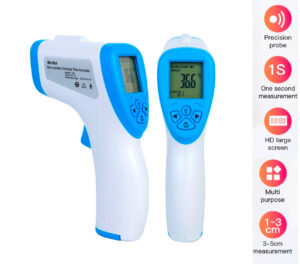
How to use an infrared thermometer to test skin temperature: When it comes to non-invasive and sterile ways to accurately measure temperature, infrared thermometers are a top choice. They’ve become especially popular for detecting fever without needing to make direct contact with a person.
Using an infrared thermometer to test skin temperature is easy once you know the steps involved.
In this article, we’ll discuss how infrared thermometers work, how accurate they are, and the steps you should follow to get the best result.
How do infrared thermometers work?
Infrared thermometers are digital devices that use infrared light to measure an object’s temperature.
They work by emitting infrared light from an LED or laser diode and measuring the amount of light reflected or absorbed by the tested object. The object’s temperature will affect how much infrared light it reflects or absorbs.
You’ll often find infrared thermometers used to measure surface temperatures, like those of an engine or piece of metal, or for testing hot spots in electrical wiring. And commonly now, you’ll see medical professionals aiming them at a person’s temple or forehead to measure their body temperature. How to use an infrared thermometer to test skin temperature
Steps for testing skin temperature
While taking skin temperature with an infrared thermometer is simple and easy, you can take some specific steps to guarantee an accurate outcome.
First, you’ll need to make sure you have the right kind of infrared thermometer before you get started. Some are more appropriate for domestic or industrial use, while others are specifically made for medical use.
Ideally, choose a high-quality and FDA-certified infrared thermometer designed for body temperature measurement. These varieties normally cover a smaller temperature range, making them more accurate.
Once you’re sure you have the right tool on hand, follow these steps:
- Read the device’s instruction manual carefully.
- Thoroughly clean and dry the thermometer, ensuring it’s free from moisture, smoke, dirt, frost, or other contaminants.
- Turn the thermometer on as per the manual. You might need to press a button on the side or click the trigger.
- Adjust the settings to suit your needs. For example, choose the right temperature unit (°C/°F) and the appropriate mode (most medical models will have a ‘Body’ mode for taking skin temperature).
- Choose the best body part to skin. Scanning the forehead is the easiest option, although the temperature can be affected by external weather conditions. Sometimes, screening the wrist or armpit is more accurate.
- Keep the thermometer close to your target. Refer to the manual to check the distance-to-spot radio, which reflects the size of the measurable area against how far back you’re holding the device.
- Aim the device at the chosen body part and pull the trigger. The temperature reading should immediately appear on the digital display.
- If the temperature result is normal, most devices will beep softy and display a green light. If the result indicates a fever, most devices will show a red light and beep loudly.
Are infrared thermometers accurate?
Yes, high-quality infrared thermometers are extremely accurate when used correctly! Make sure to follow the steps we’ve outlined in this article, and you should have no trouble obtaining an accurate and reliable skin temperature reading.

